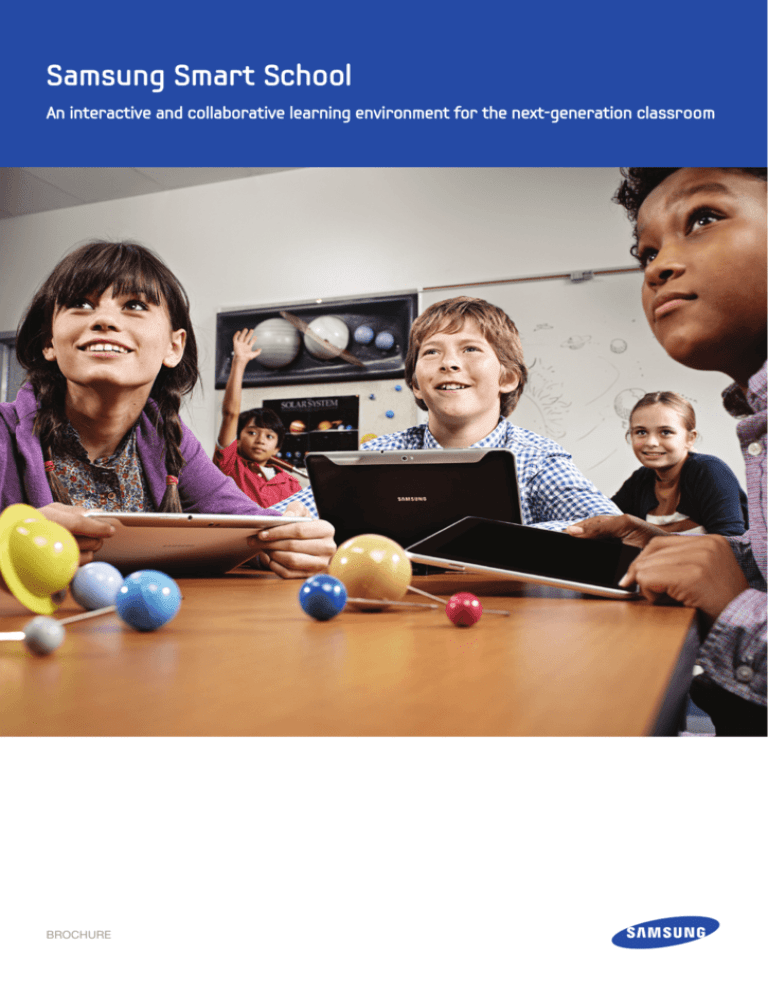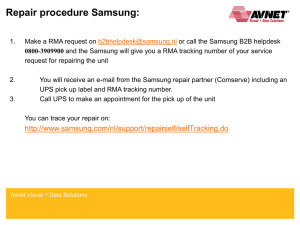
Samsung Smart School
An interactive and collaborative learning environment for the next-generation classroom
BROCHURE
Discover new avenues for students to
learn and educators to manage.
Explore new ways to enhance learning and
productivity
Digital education solutions for the nextgeneration classroom
Schools have an essential role in preparing students to become productive members of society. Educators around the
world have the same vision for their schools:
As demand for digital education tools grows, device
manufacturers and solution providers are realizing emerging
opportunities in the academic field. Governments are
beginning to understand the importance of adapting to the
changing needs of tech-savvy students. As a result, many
governments are implementing aggressive initiatives, such
as digitizing public school textbooks. Their primary goal is
to make fundamental improvements to education through
interactive teaching tools in the classroom and beyond.
•
Provide a superior-quality educational experience
•
Nurture a professional, highly skilled teaching staff to
help students reach their full potential.
•
Manage their schools in an efficient and cost-effective
manner.
Although most educators are aware of these planned
changes, many are uncertain about how the classroom
teaching environment will change. However, progressive
schools are implementing electronic classroom teaching
tools and are finding improved results in learning engagement and classroom management.
As education needs evolved, educational software, digital
books and applications have increased in availability. Also,
as technology advances with the proliferation of Internetconnected mobile devices, such as smart phones and
tablets, users are finding new methods to share information. As a result, educators are exploring ways to use these
tools in the classroom to enhance learning and productivity.
Most modern classrooms are expected to be connected to
the Internet through Wi-Fi or wireless broadband and are
equipped with desktop PCs, notebooks and even tablet
PCs. Classrooms are evolving from isolated learning environments into global collaborative learning centers.
The Samsung Smart School solution helps boost student
retention rates by providing an interactive learning
environment where they actively participate in the lesson.
Students become more engaged in the subject matter with
hands-on experience and collaboration in the classroom
and beyond, helping them to retain what they learn.
Internet access in schools, along with digital content development and learning management systems, has fostered
real-time communication between students and teachers.
Figure 1. Paradigm shift in education from teacher-centric to student-centric
learning methods
BROCHURE
2
Engage students and enhance classroom
management with advanced digital
technology solutions.
Create an interactive and collaborative learning
environment with Samsung Smart School
The Samsung Smart School solution incorporates an eBoard and a network environment in each classroom. A
central server in the school stores course content and user
information. Teachers can either use a tablet or PC, which
are mirrored to the e-Board, and can share their screen with
students. Students can participate in the Samsung Smart
School class using their tablets.
Teachers are finding it increasingly difficult to provide personalized attention to students. This challenge is becoming a serious concern among K-12 educators. As a result,
teachers are looking for dynamic new ways to engage students in the learning experience. Educators need to focus
on tools that not only motivate students to learn, but also
increase collaboration and enthusiasm. Advances in digital
technology have opened new avenues of communication,
which are being translated into valuable teaching tools.
“At Memphis City Schools, our students
come first and we strive to provide them with
a well-rounded education and all the necessary elements to thrive, both in school and in
their future adult lives.”
Samsung Smart School is a total digital education solution
that integrates the Samsung GALAXY Note 10.1 tablet with
an interactive solution. This innovative solution helps teachers engage their students and provide classroom management at heightened levels of efficiency. Thus far, no other
electronics manufacturer has developed a total learning
soultion specifically for the education market.
– Cleon Franklin,
Director of Instructional Technology,
Memphis City School District
Samsung Smart School includes the following key features:
•
Interactive Teaching. Supports in-class interaction using functions such as screen sharing, screen monitoring
group activity, quiz and poll and much more.
•
Learning Management. Aids teachers in course management, administration and lesson planning
Screen Sharing
Screen Monitoring
Quiz and Poll
Teacher’s Tab
Teacher’s PC
Lock & Auto Launch
Course Management
Mirroring
Group
Activity
User Management
Content Management
E-board
TV
Server
Student Group A
Figure 2. Samsung Smart School solution structure
BROCHURE
3
Student Group B
Share and monitor content with the
Interactive Teaching feature.
Encourage students to learn with Interactive
Teaching
Screen Monitoring
Teachers can see students’ screens in thumbnail format
and choose a student’s screen to display in a larger format
on the teacher’s e-Board. Samsung’s AllShare Cast dongle
accessory enables wireless screen sharing between the
teacher’s tablet and e-Board. The Screen Monitoring feature
also enables teachers to monitor each student’s progress
or activity and share it with the class through the teacher’s
e-Board. Teachers can use the Private Teaching function,
which permits monitoring and controlling a student’s device
remotely.
Samsung Smart School provides a dynamic student
learning experience for real-time interactions between the
teacher and fellow students. Using Samsung GALAXY Note
10.1 tablets and Interactive Teaching features, designed to
enhance teacher-to-student interaction, students can actively participate in the learning experience. Implementation
of this solution can result in better student engagement.
Samsung Smart School Interactive Teaching features include:
Also, while sharing a screen, a teacher can assign a
presenter who can be authorized to write on to the screen,
which is then instantly shared with other classmates. This
function encourages student engagement and participation
in the class.
Screen Sharing
Teachers with tablets or PCs can display content on students’ tablets and students can share content and their
notes with teachers. Page synchronization on Content
Viewer, real-time screen sharing and file transfer capabilities
are also available for a teacher and students.
Figure 4. Teachers can see students’ screens in thumbnail format on their tablet
and mirror the image on their e-Board using the AllShare Cast dongle accessory.
Figure 3. The Screen Sharing feature offers real-time screen sharing and file
transfers between teacher and students.
BROCHURE
4
Organize and simulate group discussion
with the Group Activity feature
Lock and Auto Launch
Group Activity
The Lock feature enables teachers to block screen
interactions and applications to help control non-classrelated activity. If required, the teacher can shut down
all students’ devices at one time. Using the Auto Launch
feature, teachers can activate a URL, application or
timer. Teachers can send website URLs needed for the
class directly to the students’ tablets or activate learning
applications. This feature is designed to aid teachers in
using learning resources and guiding students in class.
The Group Activity feature helps encourage interactivity and
group participation among students. Included in the Group
Activity feature are Joint Work and Group Discussion functions.
Under a group leader’s guidance, an image is split into sections on the tablet for a group activity. Each group leader
shares one part of the assignment with each member of the
group. When the members of the group have completed their
individual parts of the assignment, the group leader combines
the parts using the Joint Work function. The group leader then
sends the combined group assignment to the teacher.
The group leader can assign a presenter to navigate the
pages or add notes on the screen to share among the group
members or class. This method uses the Group Discussion
function and encourages group activities.
Figure 5. The Lock feature enables teachers to shut down student devices at
one time, as shown here, to get student attention.
Figure 6. The Group Activity feature splits the screen content onto multiple
screens to share and compare side-by-side.
BROCHURE
5
Encourage class participation and
monitor student progress
Quiz and Poll
Content Viewer
Teachers can create various templates to conduct quizzes
or polls. Quizzes can be prepared by the teacher before
class and polls can be administered during class.
Microsoft® PowerPoint®, Microsoft Word®, and PDF files
can be viewed using Content Viewer. Images in JPEG, PNG,
GIF and BMP formats can also be viewed using this feature.
Students can access the content prepared by the teacher
prior to the class. On this viewer, the teacher and students
can access hyperlinks and web links directly.
Figure 7. Teachers can administer quizzes or conduct polls and receive real-time
results with the Quiz and Poll feature.
Figure 8. Students can access content previously prepared by the teacher on
their tablets with Content Viewer.
BROCHURE
6
Share results with writing or drawing
on tablets and effectively manage class
schedule
Whiteboard and S Note
Time Management
Teachers can preset timetable roll calls before a class
begins. Time Awareness function then opens a scheduled
class according to the timetable. Teachers can also open
temporary classes, which are independent of the timetable.
Teachers can display multiple pages on their e-Boards. The
included S Pen enables teachers and students to take private
notes on their devices using the S Note function during class.
Samsung’s S Pen provides responsive, pressure-sensitive
handwriting functionality for a realistic writing experience. In
addition, the productivity functions provided in the S Note interface transform handwriting and drawn objects into typewritten text and perfect shapes. The content can then be saved in
JPG or PDF format and exported for sharing.
Figure 10. On the Main Screen, the timetable, school notices and message
board are shown. The teacher and students can enter the current class or access Contents Library.
Figure 9. Multiple pages can be displayed on the teacher’s e-Boards.
BROCHURE
7
Handle course management, content
and communications directly from the
tablet
Manage course and user information with
Learning Management
“I used to hand out pictures or copies of
articles, but now students can search for
themselves. So I don’t need to spend time in
front of the copy machine.”
Classroom management and lesson planning can be daunting tasks for teachers. With Learning Management, teachers can handle these functions more easily by performing
them electronically using their GALAXY Note 10.1 tablets.
Samsung Smart School also includes valuable features for
administrators to use in the management of school information.
- Gi-Sung Cho, Teacher
Gyeseong Elementary School
Samsung Smart School’s Learning Management features
include:
Communication
A teacher and student can communicate with the Messaging function. Students can ask questions or send their opinions to the teacher. The Messaging function also includes
the Board and Forum function. Teachers can use this function to create a forum on each class subject where students
can discuss and share ideas with each other.
Course Management
This function is designed to help school manage the course
enrollment, class allocation and timetable scheduling functions. Course Management helps manage multiple courses,
teachers and students, times and locations, attendance,
penalties and rewards, boards, forums, content, quizzes and
polls, reports and scores.
Notice Board
Teachers can share public announcements about the school
with the Notice Board function. Announcements are shown
on the main screen when students log in on their devices.
User Management
Information, including names of teachers and students,
can be added, edited or deleted. Teachers can import and
export student information, attendance and grades.
Content Management
Teachers can share local files, photos, audio recordings,
movies, applications and URLs in Contents Library. Content
Management includes My Box for teacher-only use and
Public Box for sharing with students. Students can access
the Public Box and download learning content previously
uploaded by the teacher. In addition, teachers can centralize
and manage student test records, questions, quizzes and
polls with Quiz Bank.
BROCHURE
8
Plan and conduct daily class activities
with Smart School features.
Samsung Smart School classroom scenario
When a teacher assigns a group activity to the class, students can produce their finished work with Joint Work and
Group Discussion functions. If students have questions or
opinions, they can send them back to the teacher’s device
through the Messaging function. The teacher can answer
the questions or share opinions with students using Messaging, as well. Students can present and share their group
work or personal work with the rest of the class by broadcasting it on the e-Board.
The following examples describe how the Samsung Smart
School solution functions in a typical smart school environment:
1. Preparation using Course Management, User
Management and Contents Management
At the beginning of the academic year, class administrators
can share information about the semester class, subjects,
teachers and students using tablets. After the information
is finalized, teachers can plan their class schedules and
upload class materials. Students then gain access to the
class materials in advance and can prepare for the upcoming class.
To help ensure that all students pay attention in class, the
teacher can use the Lock and Launch feature to block
non-class-related applications, URLs and other content on
students’ devices.
4. Evaluation using Quiz and Poll
2. Start class using Time Awareness, Screen Monitoring,
Lock and Launch and Content Viewer
Teachers can monitor and evaluate students’ degree of
understanding and performance with a quiz, which can be
prepared prior to class. Teachers can also give an instant
poll during class. Because teachers can almost instantly
check response rates, they can determine if students need
individual attention.
As the class commences, teachers can monitor students’
screens in thumbnail format on their tablets to determine
if everyone is ready to participate. By monitoring students’
screens, teachers can point out which students are not
ready for class and lead them to pay attention by locking
their screens. Also, by sharing URLs, teachers can direct
students to video clips related to the class materials, helping
to increase student interest. When the class starts, students
can access the content prepared by the teacher.
5. Wrap up using Content Management and Communication (Board and Forum)
After classes, students can check the Contents Library
and download materials related to the class. This access
enables students to review what they learned in the class
and prepare for the next class. Students can discuss the
subject matter with fellow students and share their thoughts
using the Board and Forum feature, which is available for
each subject.
3. Class in progress using Screen Sharing, Whiteboard
and S Note, Lock and Launch, Communication
(Messaging) and Screen Monitoring
Teachers can share their own tablet screens and notes with
students by using the Screen Sharing feature. The teacher
can give a student permission to write on the screen that is
being shared with the class. During class, students can take
notes using the S Pen and S Note features. The teacher can
launch educational applications on the students’ devices to
help lead the class.
Initial testing in actual classrooms showed
that Samsung Smart School increased
school competitiveness and improved student concentration by 23 percent. Teacher
productivity was improved by approximately
10 percent.
BROCHURE
9
Plan and conduct daily class activities
with Smart School features.
Transform the educational experience with
Samsung Smart School
Key features and benefits
Features
Educational institutions are always seeking new ways to
enhance the learning experience. While providing critical
personalized attention to students, the management of class
activities, students’ progress, and lesson plans is a daunting
task for teachers. This drives an increasing demand for digital technology within the education market.
As the technology industry continues to evolve, it brings
new opportunities for schools and teachers to find innovative tools to enhance student education. Today’s tech-savvy
K-12 pupils have grown up with electronic devices. As a
result, they are more responsive to technology and better
engaged in the learning experience when these tools are
part of their classroom environment.
Benefits
Screen Sharing
Teachers and students can share content with
each other, providing dynamic interaction among
all participants in the class.
Screen Monitoring
Teachers can remotely monitor students’ progress
and activities. Also, a student’s device screen can
be shared on a large screen by using an e-Board
for student presentations.
Lock and Auto Launch
To help ensure proper and secure use of student
tablets, teachers can remotely lock students’ applications, screens and input functionality.
With Auto Launch, teachers can activate and
open useful URLs and applications on students’
tablets.
Group Activity
Samsung is the first and only electronics manufacturer to
date to develop a total learning solution tailored specifically to the education environment. Samsung Smart School
provides rich Interactive Teaching features designed to
encourage students to become active participants in the
classroom. Studies have shown that this type of interactive
teaching method greatly improves student retention.¹
Content can be split on multiple screens to share
and compare side-by-side.
Students can have a group discussion by sharing
screens and assigning a group presenter.
In addition, the solution includes Learning Management features, which include robust functions to help teachers with
classroom management. Teachers can use these functions
to more efficiently share lesson plans and provide personalized help to students who need further tutoring. Each task is
handled directly through the teacher’s tablet and PC as well.
Information management aids teachers in managing student
data, such as general information, attendance and so on.
Students can also access course information and learning
content more easily with this feature.
With extensive expertise in developing e-Boards, tablets
and related software, Samsung has successfully implemented the Smart School Solution in eight K-12 schools in
South Korea.
This technology helps keep students engaged, helps foster
a positive learning experience and helps teachers provide
personalized attention and improved classroom management. Educators can no longer ignore the potential benefits
of electronic learning tools in the classroom environment.
BROCHURE
10
Quiz and Poll
Teachers can administer quizzes, conduct polls
and quickly assess how well the class comprehends materials.
Course Management
Information, such as term, timetable, contents,
related to subject can be managed fitting to each
school.
Contents Library
Teachers can upload a variety of class and learning materials. Students can download the materials they need onto their devices.
Samsung Smart School
Device specifications
Solution system requirement
Items
Server hardware
Server software
Client
Requirements
(Based on 100 student users)
CPU: Quad-core processor 2.0 GHz
RAM: 8 G
Above HDD: 1 TB (7,200 RPM)
OS: Microsoft Windows Server® 2008 R2
Browser: Microsoft Internet Explorer® 8, Internet
Explorer 9
Note: When multiple users download files at the same
time, the network environment may be affected.
Java™: 1.6
WAS: Apache Tomcat™ 6
DB: PostgreSQL® 9.1
Tablet
GALAXY Note 10.1
PC
CPU: Intel® Pentium Processor 1.8 GHz (Intel Core 2
Duo 2.0 GHz or higher recommended)
RAM: 1 GB
HDD: 500 MB
OS: Windows XP® SP3, Windows Vista®, Windows 7®
Resolution: 1,024 x 768 (600), 32 bit
Prerequisites: Microsoft.NET Framework v3.5 SP1,
Microsoft DirectX® v9.0 or higher
Wireless network
Items
AP; Enterprise-level, 802.11n, 5 GHz, Channel Bonding
(20 users per access point)
Note: Network quality may be affected by environmental conditions such as classroom space, arrangement
and network device models. Therefore, professional
support for network setup is recommended.
TVs and e-Boards
Note: GALAXY Note 10.1 features wireless screen
sharing for TVs by way of AllShare Cast (HDMI® supported)*
Samsung Smart School PC client enables e-Board
input from electronic boards (HID interface supported).
*Available on HDMI® supported devices only
BROCHURE
11
Samsung GALAXY Note 10.1
specifications
Display
25.64 cm (10.1 in.) Wide Extended Graphics
Array (WXGA)
Processor
1.4 GHz quad-core
Memory
2 GB RAM
Storage
16, 32, 64 GB + MicroSD
Front camera
1.9 MP FF (720 p HD recording)
Rear camera
5 MP AF with LED Flash (720 p HD recording)
Dimensions
262 mm x 180 mm x 8.9 mm
(10.32 in. x 7.1 in. x 0.35 in.)
Weight
600 g (1.32 lb)
Battery
7,000 mAh
OS version
Android™ 4.0 Ice Cream Sandwich and Jelly Bean (JB)
Additional features
TouchWiz, Hubs, AllShare Cast,
Wi-Fi channel bonding, Dropbox
Digital pen writing
S Pen embedded, Pen UX (S Note, S Planner) Adobe®
Photoshop® Touch
Legal and additional information
About Samsung Electronics Co., Ltd.
Samsung Electronics Co., Ltd. is a global leader in semiconductor, telecommunication, digital media and digital
convergence technologies with 2011 consolidated sales of
US$143.1 billion. Employing approximately 222,000 people in
205 offices across 71 countries, the company operates two
separate organizations to coordinate its nine independent
business units: Digital Media & Communications, comprising
Visual Display, Mobile Communications, Telecommunication
Systems, Digital Appliances, IT Solutions, and Digital Imaging;
and Device Solutions, consisting of Memory, System LSI and
LED. Recognized for its industry-leading performance across a
range of economic, environmental and social criteria, Samsung Electronics was named the world’s most sustainable
technology company in the 2011 Dow Jones Sustainability
Index. For more information, please visit www.samsung.com.
Copyright © 2012 Samsung Electronics Co. Ltd. All rights reserved. Samsung
is a registered trademark of Samsung Electronics Co. Ltd. Specifications
and designs are subject to change without notice. Non-metric weights and
measurements are approximate. All data were deemed correct at time of
creation. Samsung is not liable for errors or omissions. All brand, product,
service names and logos are trademarks and/or registered trademarks of
their respective owners and are hereby recognized and acknowledged.
Adobe and Photoshop are either registered trademarks or trademarks of
Adobe Systems Incorporated in the United States, and /or other countries.
Apache Tomcat and Tomcat are trademarks of the Apache Software Foundation.
Intel Pentium is a trademark or registered trademark of Intel Corporation or its
subsidiaries in the United States and other countries.
Java and all Java-based trademarks and logos are trademarks or registered
trademarks of Oracle and/or its affiliates.
For more information
Juniper is a registered trademark of Juniper Networks, Inc. in the United
States and other countries.
For more information about the Samsung Smart Education,
visit www.samsung.com/SmartSchool or contact
smartedu@samsung.com.
Microsoft, DirectX, Internet Explorer, Windows Server, Windows 7, Windows
XP and Windows Vista are trademarks of Microsoft Corporation in the United
States, other countries, or both.
PostgreSQL is a trademark of EnterpriseDB Corporation.
1. IDC Government Insights, “The Next-Generation Classroom: Smart, Interactive and Connected Learning Environments.” Document #AP779305V, a
white paper sponsored by Samsung, October 2012.
2. Source: Adapted from http://siteresources.worldbank.org/
DEVMARKETPLACE/Resources/Handout_TheLearningPyramid.pdf and the
National Training Laboratories, Bethel, Maine.
Samsung Electronics Co., Ltd.
416, Maetan 3-dong,
Yeongtong-gu
Suwon-si, Gyeonggi-do 443-772,
Korea
www.samsung.com
2013-01
12




